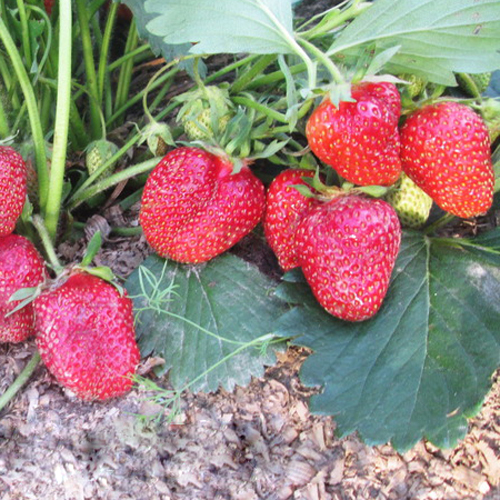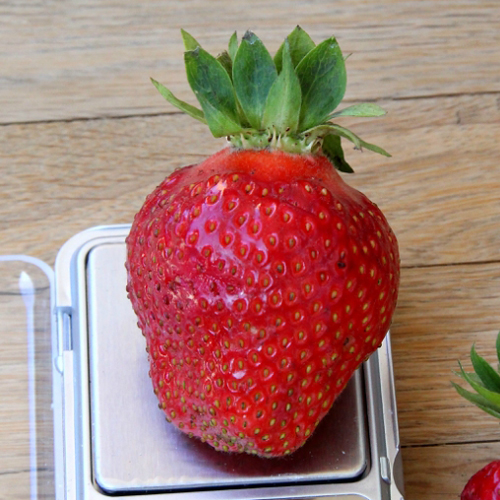Strawberry variety Tsaritsa
Tsarina is a variety of garden strawberries (strawberries) of medium ripening, universal direction of use. Bred by specialists of the All-Russian Institute of Selection and Technology of Horticulture and Nursery in Moscow. The author is Svetlana Aitzhanova. To obtain, the varieties Venta and Red Gauntlet were crossed. In 2009, after 7 years of the afterbirth of filing an application for admission, the variety was included in the state register of breeding achievements of the Russian Federation. Zoned in the Central region of the country (Vladimirskaya, Ivanovskaya, Kaluga, Bryansk, Ryazan, Smolensk, Moscow, Tula regions). Differs in drought resistance.

The plant is medium-sized, semi-sprawling, with an average amount of green mass. The leaves are large, smooth, slightly ribbed, concave. The edges of the leaf plate are serrated, the denticles are obtuse. Leaf without pubescence, glabrous, dull green color. The shape of the middle lobe of the leaf plate is obovate, acute. The petiole is of medium length, medium pubescent, the hairs are not pressed. Strawberry flowers are large, untwisted, white in color. The inflorescence is compact, the number of flowers in it is small. The plant forms bisexual flowers, therefore it does not need additional pollination. The peduncles of the variety are of medium length, located under the leaves, prone to lodging under the weight of the berries, which is often a problem - the fruits are laid on the ground and begin to rot. The queen forms a medium number of whiskers, they are of medium thickness, strongly pubescent, of a pale red color. One plant sets about 10-15 fruits.

Strawberries have a regular symmetrical wide-conical shape, without a neck. The skin is dark red with a characteristic shine. The pulp is bright red, when fully ripe, dark red, quite dense, juicy, with a weak or medium aroma. Achenes are yellow, shallowly pressed into the pulp. The Tsarina's taste is multifaceted, very pleasant, sweet and sour; tasters rated it at 4.8 points on a five-point scale. The pulp contains: 11.1% dry matter, 9% sugar, 0.9% acid, 76 mg% vitamin C.
Thanks to their dense pulp, the berries tolerate transportation well. When separated from the stalk, they are not injured, retain their attractive neat appearance. In use, they are universal, good both fresh and canned. Strawberries are also suitable for storage - fresh berries do not sour in the refrigerator, and frozen ones do not lose their shape when thawed.

The variety is of medium ripening, the beginning of the harvest is in mid-June. The queen has a rather tight fruiting period, in comparison with some other varieties, so the last collection takes place around the end of August. By the end of the season, the berries gradually decrease in size. At the beginning of fruiting, they are quite large, up to 60 grams, on average, the weight ranges from 25-35 grams. In subsequent harvests, the average weight of the fetus gradually decreases to 10-15 grams.
According to the results of state tests at the variety plots, the strawberry yield was 98.9-130 c / ha. One plant gives an average of 400-700 grams of berries per season. It should be said that such indicators cannot be called outstanding, therefore the Queen is more common in small garden plots, it is rarely grown on an industrial scale and does not withstand the competition of many other popular and higher-yielding varieties. But do not be disappointed, because our heroine has many other advantages that some varieties can only envy!

According to the State Register of Plants of the Russian Federation, the resistance of strawberries to pests and diseases is at a standard level. Other sources report that plants are especially resistant to fungal diseases, as well as mites and slugs.
The queen is distinguished by high drought and heat resistance.Many gardeners confirm the veracity of this information, and recommend the variety to those who do not have the opportunity to often visit their site and provide plants with regular watering. In addition, the variety can be successfully grown in the southern regions of the country with dry summers. The berries are not baked in the sun, which is another great advantage of our heroine. As for winter hardiness, opinions differ here. Based on the data of the state register, we can say that the resistance to frost in plants is average: with an abundance of snow, strawberries feel great, but with a small amount of it, they can seriously suffer. In particular, in the absence of snow, generative buds can be damaged by frosts up to 1.5 points at a temperature of -15 ° C. Thus, it is highly desirable to provide plants with good shelter if a winter with little snow is expected.
One of the Queen's virtues is her unpretentious care. Of course, in order to get the best harvest, you should take good care of the plantation. Before planting, the soil must be well prepared and a sufficient amount of organic and mineral fertilizers must be added to it. Despite their high drought resistance, strawberries are still moisture-loving and will respond well to regular abundant watering. You also need to pay attention to the removal of the whiskers, especially if you are growing in order to get berries, and not seedlings. In comparison with some other varieties, our heroine does not form so many mustaches, however, their number still needs to be normalized, since they take on a lot of food, and therefore the fruits get less. Otherwise, the plants do not require the creation of any special conditions, and, when carrying out the most standard agrotechnical measures, they will delight you with a good harvest.
There is, however, one caveat. The plantation needs to be renewed every 3-4 years so that the yield does not decrease. In some cases, the update may be required after 2 years of use. It is also worth noting that this strawberry is not suitable for intensive use, it is more likely a stable inhabitant of a personal plot than a bright representative who is able to provide berries for both you and your neighbors, and will even remain for sale. But on the other hand, having planted this variety, you do not have to spend a lot of time and effort on growing it.
Summarizing all of the above, it should be summed up. The queen does not differ in ultra-high yield indicators (which, by the way, are not enough for many summer residents), but she has a rather large set of advantages. This is unpretentiousness in care, and drought resistance, and resistance to many diseases. And, of course, the excellent taste of the berries and their excellent presentation. This variety is able to provide you with a really royally delicious strawberry harvest, albeit small, but very high quality.








